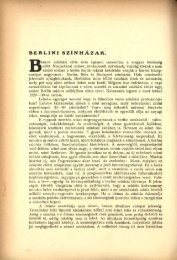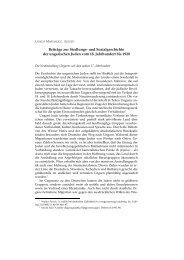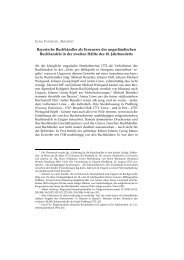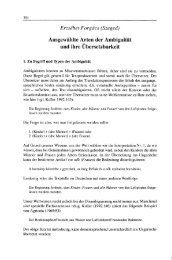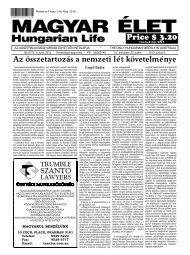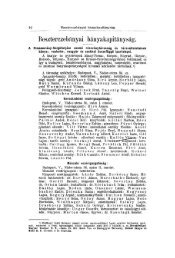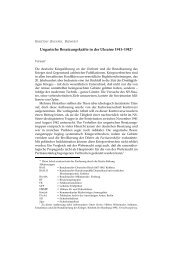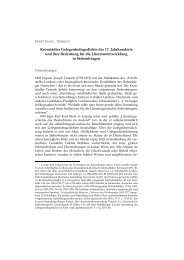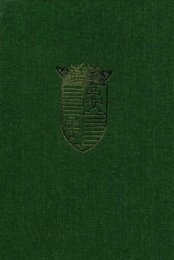Osservatorio letterario ANNO 14. – NN. 73/74 MARZ.-APR./MAGG ...
Osservatorio letterario ANNO 14. – NN. 73/74 MARZ.-APR./MAGG ...
Osservatorio letterario ANNO 14. – NN. 73/74 MARZ.-APR./MAGG ...
Create successful ePaper yourself
Turn your PDF publications into a flip-book with our unique Google optimized e-Paper software.
to that place where the eastern Magyars were living.<br />
(The name of the Atil River might mean not the Volga<br />
River itself in this case, but one of its affluents,<br />
probably the Belaja River.) It is clear that the country of<br />
the Eastern Hungarians was on the left bank of the Edil<br />
(Atil, Itil) river (of the Volga River). Having followed the<br />
indicated route, Brother Julian really found his far-living<br />
relatives, and he could make himself understood with<br />
them in the Magyar language. His meeting with the<br />
Eastern Magyars justified his hopes. As he tells it in the<br />
referred written source: “Those, when they noticed him<br />
and got to know that he is Magyar, got very glad, that<br />
he arrived. They led them around to show him their<br />
homes and settlements, giving him many questions<br />
about the king and the Kingdom of their Christian<br />
brothers. They listened to all what he wanted tell them<br />
very attentively, about faith and other things, and they<br />
understood each other, because their language is<br />
perfectly Hungarian. They are Pagans, they have no<br />
idea about God, but they neither worship idols. They<br />
live just like animals. They do not cultivate land, eat<br />
horses, wolves and anything like that; they drink<br />
horses’ milk and blood. They have many horses and a<br />
large amount of arms and they are very brave in fights.<br />
They remember that those Hungarians derive from<br />
them, but they did not know, where they could be<br />
found that time. The Tatar nation lives in their<br />
neighbourhood. But those Tatars, fighting with them,<br />
could not defeat the Magyars, on the contrary, they<br />
themselves were defeated in the first battle. For this<br />
reason, the Tatars selected them as friends and allies,<br />
and this way they devastated 15 kingdoms together”<br />
[Anninskij, 1940, p. 82]. All this confirms the<br />
information quoted from the Mongolian written source<br />
that the Eastern Magyars offered hard resistance to the<br />
Eastern conquerors and they did not get their subjects<br />
on the first occasion. The way of life of the Eastern<br />
Magyars shows them to be real Nomads. As it turns out<br />
from our narrative, they ate horse meat and drunk<br />
horses’ milk (koumiss). The most important information<br />
is the following here: the Magyars did not cultivate<br />
land, in other words: they were not ploughmen, and<br />
were abundantly supplied by horses and arms. When,<br />
having got under Tatar rule (after 1238) they got into<br />
corporal system of the Mongolian war-organization,<br />
then, on the right of the allies of the new rulers of the<br />
Steppe, they took part most actively in the wars against<br />
the neighbouring states and peoples. The famous and<br />
authentic author, Rasid-ed-Din tells us that the Magyars<br />
took part in the Mongolian campaigns of the 13 th<br />
Century where he describes the military strength of the<br />
Empire of the Džuchids, the offsprings of the eldest son<br />
of Genghis Khan: the so-called Golden Horde. The<br />
Persian historian emphasizes that “a large part of<br />
Toktay’s and Bayan’s army (from the end of the 13 3h C<br />
<strong>–</strong> to the beginning of the 14 th C.) contains the<br />
offsprings of those four thousand (Mongols <strong>–</strong> A. K.), but<br />
new Russian, Circassian, Kipchak, Madžar and other<br />
units were added to it lately” [Rasid <strong>–</strong>ad-Din 1952, p.<br />
275.]. It is well known that Tokta was one of the Khans<br />
of the Golden Horde (1291<strong>–</strong>1312). Bayan, one of the<br />
offsprings of Orda (Ichen), the first son of Džuchi, ruled<br />
on the territory of the todays’ Kazakhstan, and then he<br />
was the commander-in-chief <strong>–</strong> or one of the leaders <strong>–</strong><br />
of the so-called Kok Orda, the eastern wing of the<br />
Golden Horde.<br />
Having conquered the territory of Dest-i-Kypchak<br />
and the Western part of Eurasia, the Mongols<br />
distributed their new subjects according to the military<br />
system of Uluses and wings, arranged all effective<br />
people (mostly men) into the corporal system used by<br />
them, in order that they would fulfil their compulsory<br />
military service. This model existed for a long time and<br />
it radically changed the ethno-political situation on the<br />
conquered regions. The subjugated population was<br />
disintegrated, distributed again and again, was moved<br />
from the West to the East, from the South to the North<br />
and inversely, etc. The nomadic and land-cultivator<br />
subjects alike were obliged to follow the rulers<br />
(commanders) of their Ulus into any direction in case of<br />
war. the Turkisation of the Eastern Magyar population<br />
had begun, (or maybe, had continued), just in the<br />
Mongolian period. It is clear that the population of the<br />
Džuchi Ulus was composed mainly of those Turkishspeaking<br />
tribes, which were partly aboriginal<br />
inhabitants of Dest-i-Kyphcak, or arrived together with<br />
the Mongols from the East, from Inner and Central Asia<br />
there. The Mongols themselves <strong>–</strong> as it becomes clear<br />
from the written sources <strong>–</strong> quickly got assimilated to<br />
the local ethnic sphere, but they kept firmly their tribal<br />
and generic names. The ethnic manifoldness of the<br />
Nomad population of the Golden Horde cannot cause<br />
great surprise. It is confirmed by the latest<br />
archaeological material and by anthropological data.<br />
The “ethnic kettle” of the Golden Horde operated in the<br />
following way: Having gone through the Mongolian<br />
corporal military system, the aboriginal population and<br />
the newcomers became more or less united. The<br />
components which “melted together” from different<br />
tribal-clan groups, formed new ethnic units or became<br />
concentrated under the common self-denomination of<br />
the strongest clans. Such clans were not related in<br />
blood on the higher and middle grades of clan-macrohierarchy.<br />
However, they were united by virtual<br />
relationship on the common genealogical trees. These<br />
facts were expressed by the existence of the common<br />
“shadžra, shežire” (genealogy) of all clan-groups which<br />
stepped conditionally into a higher hierarchical order. If<br />
we consider the lower levels of these ethno-political<br />
pyramids, then, we can see that those families or<br />
groups which were in close relationship with each other<br />
could preserve their self-denomination and could keep<br />
their usual contacts on patriarchal line.<br />
What happened with those Eastern Magyars in<br />
the Mongolian period, which had been named as<br />
“Madžars” already for hundred years by then? Could<br />
they simply disappear, in other words: could they be<br />
assimilated perfectly into the “Turkish sea” of the<br />
steppes of Dest-i-Kypchak? Of course, some parts of<br />
them dispersed among the Nomads who were speaking<br />
Kypchak language, and really got assimilated to them.<br />
It is also true that those parts of the Kypchak (Kuman)<br />
tribes who offered fierce resistance to the Mongolian<br />
conquerors were destroyed physically. Others got<br />
assimilated to the new clans and tribes, and lost their<br />
earlier self-denomination. Again others, having become<br />
part of the Mongolian military system, could keep their<br />
earlier generic name. It seems that this third variation<br />
OSSERVATORIO LETTERARIO Ferrara e l’Altrove <strong>A<strong>NN</strong>O</strong> XIV <strong>–</strong> <strong>NN</strong>. <strong>73</strong>/<strong>74</strong> <strong>MARZ</strong>.-<strong>APR</strong>./<strong>MAGG</strong>.-GIU. 2010<br />
113


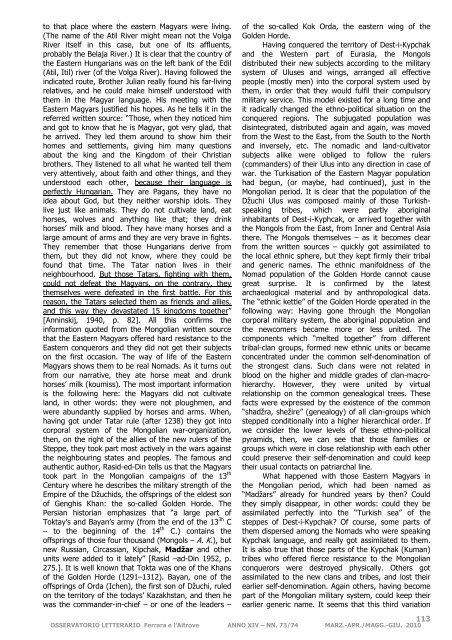
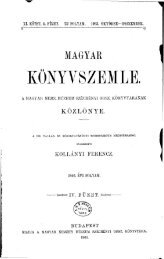
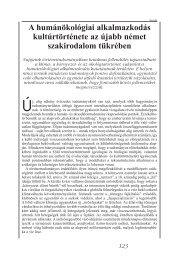
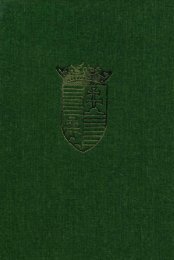
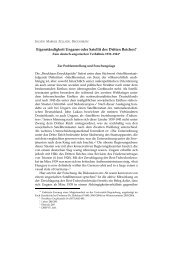
![Letöltés egy fájlban [36.8 MB - PDF] - EPA](https://img.yumpu.com/23369116/1/172x260/letoltes-egy-fajlban-368-mb-pdf-epa.jpg?quality=85)
